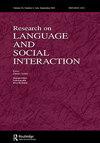Recruiting Assistance in Early Childhood: Longitudinal Changes in the Use of “Oh+X” as a Way of Reporting Trouble in German
IF 2.1
1区 文学
Q1 COMMUNICATION
引用次数: 4
Abstract
ABSTRACT Based on longitudinal audiovisual data from family interactions, we focus on how young children between 1;08 and 2;10 report trouble they are encountering in their current activity using the response cry oh in combination with other lexical items (e.g., “oh fell off”) and bodily displays. While at a very young age the children remain focused on their activity and try to solve the problem independently, at an older age they start to systematically use gaze directed toward the parent and suspension of the current activity to enlist the adult’s assistance. We argue that these bodily displays are among the resources whose presence or absence constrains whether the report of trouble leads to the recruitment of assistance or not. Regarding the developmental implications, it seems that during their third year of life, young children expand their repertoire for dealing with trouble interactively. Data are in German with English translations.儿童早期的招募援助:德语中使用“O+X”报告问题的纵向变化
摘要基于来自家庭互动的纵向视听数据,我们关注1岁以下的幼儿如何;08和2;10报告他们在当前活动中遇到的麻烦,使用回应cry oh与其他词汇(例如“哦掉下来了”)和身体表现相结合。虽然在很小的时候,孩子们仍然专注于自己的活动,并试图独立解决问题,但在年龄较大的时候,他们开始系统地使用凝视父母和暂停当前活动的方式来寻求成年人的帮助。我们认为,这些身体展示是存在或不存在的资源之一,这些资源限制了麻烦报告是否会导致招募援助。关于发展影响,似乎在他们生命的第三年,年幼的孩子们扩大了他们互动处理问题的能力。数据为德语和英语翻译。
本文章由计算机程序翻译,如有差异,请以英文原文为准。
求助全文
约1分钟内获得全文
求助全文
来源期刊
CiteScore
7.30
自引率
7.40%
发文量
20
期刊介绍:
The journal publishes the highest quality empirical and theoretical research bearing on language as it is used in interaction. Researchers in communication, discourse analysis, conversation analysis, linguistic anthropology and ethnography are likely to be the most active contributors, but we welcome submission of articles from the broad range of interaction researchers. Published papers will normally involve the close analysis of naturally-occurring interaction. The journal is also open to theoretical essays, and to quantitative studies where these are tied closely to the results of naturalistic observation.

 求助内容:
求助内容: 应助结果提醒方式:
应助结果提醒方式:


